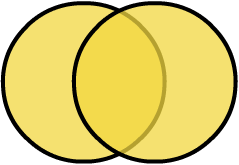Summary: in this tutorial, you will learn how to emulate SQLite full outer join using the UNION and LEFT JOIN clauses.
Introduction to SQL FULL OUTER JOIN clause
In theory, the result of the FULL OUTER JOIN is a combination of a LEFT JOIN and a RIGHT JOIN. The result set of the full outer join has NULL values for every column of the table that does not have a matching row in the other table. For the matching rows, the FULL OUTER JOIN produces a single row with values from columns of the rows in both tables.
The following picture illustrates the result of the FULL OUTER JOIN clause:

See the following cats and dogs tables.
-- create and insert data into the dogs table
CREATE TABLE dogs (
type TEXT,
color TEXT
);
INSERT INTO dogs(type, color)
VALUES('Hunting','Black'), ('Guard','Brown');
-- create and insert data into the cats table
CREATE TABLE cats (
type TEXT,
color TEXT
);
INSERT INTO cats(type,color)
VALUES('Indoor','White'),
('Outdoor','Black');Code language: SQL (Structured Query Language) (sql)The following statement uses the FULL OUTER JOIN clause to query data from the dogs and cats tables.
SELECT *
FROM dogs
FULL OUTER JOIN cats
ON dogs.color = cats.color;Code language: SQL (Structured Query Language) (sql)The following shows the result of the statement above:
| Type | Color | Type | Color |
|---|---|---|---|
| Hunting | Black | Outdoor | Black |
| Guard | Brown | NULL | NULL |
| NULL | NULL | Indoor | White |
Unfortunately, SQLite does not support the RIGHT JOIN clause and also the FULL OUTER JOIN clause. However, you can easily emulate the FULL OUTER JOIN by using the LEFT JOIN clause.
Emulating SQLite full outer join
The following statement emulates the FULL OUTER JOIN clause in SQLite:
SELECT d.type,
d.color,
c.type,
c.color
FROM dogs d
LEFT JOIN cats c USING(color)
UNION ALL
SELECT d.type,
d.color,
c.type,
c.color
FROM cats c
LEFT JOIN dogs d USING(color)
WHERE d.color IS NULL;Code language: SQL (Structured Query Language) (sql)How the query works.
- Because SQLilte does not support the
RIGHT JOINclause, we use theLEFT JOINclause in the secondSELECTstatement instead and switch the positions of thecatsanddogstables. - The
UNION ALLclause retains the duplicate rows from the result sets of both queries. - The
WHEREclause in the secondSELECTstatement removes rows that already included in the result set of the firstSELECTstatement.
In this tutorial, you have learned how to use the UNION ALL and LEFT JOIN clauses to emulate the SQLite FULL OUTER JOIN clause.